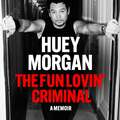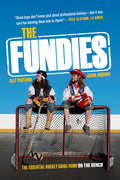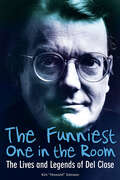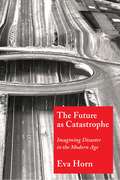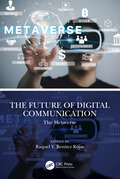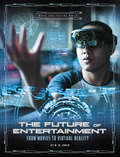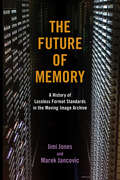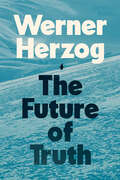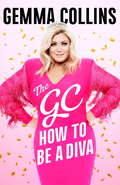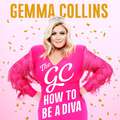- Table View
- List View
The Fun Lovin’ Criminal
by Huey MorganWhen Fun Lovin' Criminals released their debut album Come Find Yourself in 1996, its fusion of hip-hop, funk, blues and rock quickly became one of the most iconic and influential records of the decade. Now, in this fascinating memoir, frontman Huey Morgan describes his remarkable journey from journeyman to rock star.This is a story that begins in the early 1990s with a young man who, after returning to New York City from his time as a United States Marine, is struggling to cope with normal life. Huey begins his quest to become a rock star only to be sidetracked by his association with the New York criminal underworld. But as his band begins to take off, can he extract himself before his chance of stardom goes begging?Written in Huey's indomitable and distinctive style, this is a book that brings the grit and glamour of 90s New York brilliantly to life.
The Fun Lovin’ Criminal
by Huey MorganWhen Fun Lovin' Criminals released their debut album Come Find Yourself in 1996, its fusion of hip-hop, funk, blues and rock quickly became one of the most iconic and influential records of the decade. Now, in this fascinating memoir, frontman Huey Morgan describes his remarkable journey from journeyman to rock star.This is a story that begins in the early 1990s with a young man who, after returning to New York City from his time as a United States Marine, is struggling to cope with normal life. Huey begins his quest to become a rock star only to be sidetracked by his association with the New York criminal underworld. But as his band begins to take off, can he extract himself before his chance of stardom goes begging?Written in Huey's indomitable and distinctive style, this is a book that brings the grit and glamour of 90s New York brilliantly to life.
The Fundies: The Essential Hockey Guide from On the Bench
by Olly Postanin Jacob ArdownPutting the old-school grease back in hockey, in the first ever written eppie!Do you have trouble sniping top corns or landing a big conny? Keep missing the net in praccy or losing all your tillys? Well boys, you might need the fundies. Canadian beauties Olly Postanin and Jacob Ardown are natural athletes, and are here to show you how to be a weapon on the ice. All the big-leaguers (like Connor McDavid and Drew Doughty, not a big deal) come to Olly and Jacob for help on hockey fundamentals (the fundies); now you can get the insider tips and tricks to become a legend yourself. With their crucie knowledge of what makes hockey the best game in the world and all the greatest chirps, there is no other book like The Fundies. This guide to dominating the sport covers everything: history, skills development, throwing folded fives, training and choosing equipment, coaching, and all the ways to get respect on and off the ice. The boys will grease you through all you need to know and, if you stay focused, you’ll learn the essential skills necessary to dominate in the game. Throw on a bucket: you’re about to be hit with some grade A knowledge. From blocking biscuits and tickling twine to the perfect post-goal celly to impress the scouties, The Fundies is here to teach you how hockey is supposed to be played.
The Funniest One in Room: The Lives and Legends of Del Close
by Kim Howard JohnsonContaining recollections from more than 80 of the comedic giant's closest friends and colleagues, this absorbing biography explores Del Close's old haunts, his sensational past, and the reality behind the tales he told so often. From traveling with a carnival and hanging out with a pre-Scientology L. Ron Hubbard to riding with the Merry Pranksters and using a coven of witches to help him kick a lifelong cocaine habit, Close led an incredibly rich life--one whose absurdity proved great fodder for improv theater. Astute and compassionate, Close influenced improvisational theater's greatest comedic talents of the last 50 years--Nichols and May, Lenny Bruce, Bill Murray, Chris Farley, Tina Fey--and coached the witty masterminds behind such comedic institutions as Second City, Saturday Night Live, Groundlings, and the Upright Citizen's Brigade.
The Funny Side of Faith: A Lighthearted Look at Life in the Church
by Murray WattsOops! There's pie on our face More fun than a potluck supper, these delightful anecdotes, tongue-in-cheek wisecracks, and verbal miscues will leave you laughing in the aisles. Need a quip to lift your spirits? A one-liner for your next sermon? THE FUNNY SIDE OF FAITH serves up the inside scoop on God's family with delectible wit and humor. A delight to all who enjoy the gift of laughter. Best of all, the jokes are on us!
The Further Adventures of a London Call Girl
by Belle de Jour''She lists like Hornby. She talks dirty like Amis. She has the misanthropy of Larkin and examines the finer points of sexual technique as she is adjusting the torque on a beloved but temperamental old E-type...It's hard to believe that this clever and candid new voice has no more to say. Whoever the author is, she should give up the day job. Only then will we find out what the real Belle de Jour is made of.' IndependentThis follow-up to the hugely successful 'Intimate Adventures' will be just as bold, funny and brilliant. Peppered with agony-aunt letters and advice, and stories from her 'working' life, it's also the story of a young woman making her way in the world - told in Belle's inimitable voice.
The Further Adventures of a London Call Girl
by Belle de Jour''She lists like Hornby. She talks dirty like Amis. She has the misanthropy of Larkin and examines the finer points of sexual technique as she is adjusting the torque on a beloved but temperamental old E-type...It's hard to believe that this clever and candid new voice has no more to say. Whoever the author is, she should give up the day job. Only then will we find out what the real Belle de Jour is made of.' IndependentThis follow-up to the hugely successful 'Intimate Adventures' will be just as bold, funny and brilliant. Peppered with agony-aunt letters and advice, and stories from her 'working' life, it's also the story of a young woman making her way in the world - told in Belle's inimitable voice.
The Future Was Now: Madmen, Mavericks, and the Epic Sci-Fi Summer of 1982
by Chris Nashawaty“Hollywood boldly went where it hadn’t gone before and Nashawaty chronicles the journeys.” —Los Angeles Times ("Books You Need To Read This Summer")“Written with a fan’s enthusiasm . . . An important inflection point in Hollywood filmmaking.” —New York Times ("Nonfiction Books to Read This Summer")In the summer of 1982, eight science fiction films were released within six weeks of one another. E.T., Tron, Star Trek: Wrath of Khan, Conan the Barbarian, Blade Runner, Poltergeist, The Thing, and Mad Max: The Road Warrior changed the careers of some of Hollywood's now biggest names—altering the art of movie-making to this day.In The Future Was Now, Chris Nashawaty recounts the riotous genesis of these films, featuring an all-star cast of Hollywood luminaries and gadflies alike: Steven Spielberg, at the height of his powers, conceives E.T. as an unlikely family tale, and quietly takes over the troubled production of Poltergeist, a horror film he had been nurturing for years. Ridley Scott, fresh off the success of Alien, tries his hand at an odd Philip K. Dick story that becomes Blade Runner—a box office failure turned cult classic. Similar stories arise for films like Tron, Conan the Barbarian, and The Thing. Taken as a whole, these films show a precarious turning-point in Hollywood history, when baffled film executives finally began to understand the potential of high-concept films with a rabid fanbase, merchandising potential, and endless possible sequels.Expertly researched, energetically told, and written with an unabashed love for the cinema, The Future Was Now is a chronicle of how the revolution sparked in a galaxy far, far away finally took root and changed Hollywood forever.
The Future as Catastrophe: Imagining Disaster in the Modern Age
by Eva HornWhy do we have the constant feeling that disaster is looming? Beyond the images of atomic apocalypse that have haunted us for decades, we are dazzled now by an array of possible catastrophe scenarios: climate change, financial crises, environmental disasters, technological meltdowns—perennial subjects of literature, film, popular culture, and political debate. Is this preoccupation with catastrophe questionable alarmism or complacent passivity? Or are there certain truths that can be revealed only in apocalypse?In The Future as Catastrophe, Eva Horn offers a novel critique of the modern fascination with disaster, which she treats as a symptom of our relationship to the future. Analyzing the catastrophic imaginary from its cultural and historical roots in Romanticism and the figure of the Last Man, through the narratives of climatic cataclysm and the Cold War’s apocalyptic sublime, to the contemporary popularity of disaster fiction and end-of-the-world blockbusters, Horn argues that apocalypse always haunts the modern idea of a future that can be anticipated and planned. Considering works by Lord Byron, J. G. Ballard, and Cormac McCarthy and films such as 12 Monkeys and Minority Report alongside scientific scenarios and political metaphors, she analyzes catastrophic thought experiments and the question of survival, the choices legitimized by imagined states of exception, and the contradictions inherent in preventative measures taken in the name of technical safety or political security. What makes today’s obsession different from previous epochs’ is the sense of a “catastrophe without event,” a stealthily creeping process of disintegration. Ultimately, Horn argues, imagined catastrophes offer us intellectual tools that can render a future shadowed with apocalyptic possibilities affectively, epistemologically, and politically accessible.
The Future of Audiences: A Foresight Analysis Of Interfaces And Engagement
by Brita Ytre-Arne Ranjana DasThis book brings together contributions from scholars across Europe to present findings from a foresight analysis exercise on audiences and audience analysis, looking towards an increasingly datafied world and anticipating the ubiquity of the internet of things. The book uses knowledge emerging out of three foresight exercises, produced in co-operation with more than 50 stake-holding organisations and building on systematic reviews of audience research. It works through these exercises to arrive at a renewed agenda for audience studies within communication scholarship in the context of intrusive and connected interfaces and emerging communicative practices.
The Future of Digital Communication: The Metaverse
by Raquel V. Benítez RojasThis collection of essays explores the present and future of digital communication through a range of interdisciplinary approaches, all of which focus on the so-called metaverse. The metaverse is a combination of multiple elements of technology – including virtual reality, augmented reality, and video – where users "live" within a digital universe. The vision for this new universe is that its users can work, play, and stay connected with friends through everything. Such a vision is hinted at in existing phenomena such as online game universes.
The Future of Entertainment: From Movies to Virtual Reality (What the Future Holds)
by M. M. EbochFrom stage productions to television to movies, humans have always been entertained by a good story. But how might entertainment change in the future? From immersive virtual reality games to social media with 3-D holograms, readers can find out what cool new technologies might change the way they are entertained.
The Future of Memory: A History of Lossless Format Standards in the Moving Image Archive (The History of Media and Communication)
by Marek Jancovic Jimi JonesA new generation of video standards promises lossless storage of digital objects for future generations. Jimi Jones and Marek Jancovic document the development and adoption of JPEG 2000, FFV1, MXF, and Matroska while investigating the social and material aspects of their design and the forces driving their journeys from niche to ubiquity. Drawing on interviews with archivists and developers, Jones and Jancovic reveal the archive as a dynamic space where deeply entrenched social practices produce disagreements but also resourceful collaborations. They contrast the unprecedented rise of archivist-driven standardization and controversies around non-standard technology with the historical dominance of the film and broadcast industries. Throughout, the authors clarify the role of tech companies, software developers, film pirates, hackers, and other players with poorly understood roles in the process. A timely look at the state of audiovisual preservation, The Future of Memory provides a history of recent innovations alongside a snapshot of a field in the midst of profound technological change.
The Future of Music: Towards a Computational Musical Theory of Everything
by Guerino Mazzola Yan Pang Jason Noer Shuhui Yao Jay Afrisando Christopher Rochester William NeaceThe idea of this monograph is to present an overview of decisive theoretical, computational, technological, aesthetical, artistic, economical, and sociological directions to create future music. It features a unique insight into dominant scientific and artistic new directions, which are guaranteed by the authors' prominent publications in books, software, musical, and dance productions.Applying recent research results from mathematical and computational music theory and software as well as new ideas of embodiment approaches and non-Western music cultures, this book presents new composition methods and technologies. Mathematical, computational, and semiotic models of artistic presence (imaginary time, gestural creativity) as well as strategies are also covered.This book will be of interest to composers, music technicians, and organizers in the internet-based music industry, who are offered concrete conceptual architectures and tools for their future strategies in musical creativity and production.
The Future of Ritual: Writings on Culture and Performance
by Richard SchechnerIn The Future of Ritual, Richard Schechner explores the nature of ritualised behaviour and its relationship to performance and politics. A brilliant and uncontainable examination of cultural expression and communal action, The Future of Ritual asks pertinent questions about art, theatre and the changing meaning of 'culture' in today's intercultural world. An exciting new work by the author of Performance Theory.
The Future of Television in the Global South: Reflections from Selected Countries
by George OgolaThis book explores how television in the global South is ‘future-proofing’ its continued relevance, addressing its commercial, social and political viability in a constantly changing information ecosystem. The chapter contributions in the book are drawn from countries in East, South and West Africa, the Middle East and Latin America, specially selected for their illustrative potential of the key issues addressed in the book. Scholarly attention on television in the global South has largely been limited to studying evolving television formats with broader structural issues covered almost entirely by industry reports. Major gaps remain in terms of understanding how television in the global South is changing within the context of the significant technological developments and what this means for television’s future(s). The chapters reflect on these futures, not in the sense of predicting what these might be, but rather anticipating important areas of intellection. The contributors contend that much of the scholarship on the global South, by scholars from the South, is often stilted by a reluctance to anticipate. This failure leads to a largely reactionary scholarship, constantly oppositional, and unable to recentre conversations on the South. This volume finds intellectual incentive in this urgent need to anticipate, hence its particular focus on television futures. Taking television in the global South as an important cultural and political barometer, the book seeks to explore how television in the global South is adapting to the rampant technological changes and processes of globalisation.
The Future of Truth
by Werner HerzogFrom legendary filmmaker and author Werner Herzog, a compact, effervescent, and deeply personal exploration of art, philosophy, and history that unravels one of our most elusive and contested questions: What is truth—and how to find it in our &“post-truth&” era?For over half a century, Werner Herzog has challenged, enriched, and expanded our understanding of the truth. His films and books have mixed fiction and nonfiction, documentary and drama, reality and imagination. Invariably, Herzog goes beyond the appearance of what is true in search of a higher truth, or what he has often referred to as the &“ecstatic truth.&” In The Future of Truth, a great artist ventures an answer to one of humanity&’s deepest, most eternal questions. At a moment when deepfake AI videos are proliferating, and most people have simply thrown up their hands in despair at the ubiquity of what we now know as fake news—not to mention the constant lying and propagandizing from certain public figures—Herzog seeks a remedy. Mixing memoir, history, politics, poetry, science, and fierce opinion, he writes with dazzling originality and panache, urging readers to be unflagging and imaginative in the pursuit of truth, endless though the quest may be:I don&’t think truth is some kind of polestar in the sky that we will one day get to. It&’s more like an incessant striving. A movement, an uncertain journey, a seeking full of futile endeavor. But it is this journey into the unknown, into a vast twilit forest, that gives our lives meaning and purpose; it is what distinguishes us from the beasts in the fields.
The Future of the Nineteenth-Century Dream-Child: Fantasy, Dystopia, Cyberculture (Children's Literature and Culture)
by Amy BilloneThis book investigates the reappearance of the 19th-century dream-child from the Golden Age of Children's Literature, both in the Harry Potter series and in other works that have reached unprecedented levels of popular success today. Discussing Harry Potter as a reincarnation of Lewis Carroll's Alice and J.M. Barrie's Peter Pan, Billone goes on to examine the recent resurrection of Alice in Tim Burton's Alice, and of Peter Pan in Michael Jackson and in James Bond. Visiting trends that have emerged since the Harry Potter series ended, the book studies revisions of the dream-child in texts and films that have inspired mass fandom in the twenty-first century: Stephenie Meyer's Twilight, E.L. James's 50 Shades of Grey and Suzanne Collins's The Hunger Games. The volume argues that the 21st-century desire to achieve dream-states in relationship to eternal youth results from the way that dreams provide a means of realizing the fantastic yet alarming possibility of escaping from time. This current identification with the dream-child stems from the threat of political unrest and economic and environmental collapse as well as from the simultaneous technophilia and technophobia of a culture immersed in the breathless revolution of the digital age. This book not only explores how the dream-child from the past has returned to reflect misgivings about imagined dystopian futures but also reveals how the rebirth of the dream-child opens up possibilities for new narratives where happy endings remain viable against all odds. It will appeal to scholars in a wide variety of fields including Childhood Studies, Children's/YA Literature, Cinema Studies, Cultural Studies, Cyberculture, Gender Studies, Queer Studies, Gothic Studies, New Media, and Popular Culture.
The Futurist: The Life and Films of James Cameron
by Rebecca KeeganWith the release of Avatar in December 2009, James Cameron cements his reputation as king of sci-fi and blockbuster filmmaking. It's a distinction he's long been building, through a directing career that includes such cinematic landmarks as The Terminator, Aliens, The Abyss, and the highest grossing movie of all time, Titanic. The Futurist is the first in-depth look at every aspect of this audacious creative genius-culminating in an exclusive behind-the-scenes glimpse of the making of Avatar, the movie that promises to utterly transform the way motion pictures are created and perceived. As decisive a break with the past as the transition from silents to talkies, Avatar pushes 3-D, live action, and photo-realistic CGI to a new level. It rips through the emotional barrier of the screen to transport the audience to a fabulous new virtual world. With cooperation from the often reclusive Cameron, author Rebecca Keegan has crafted a singularly revealing portrait of the director's life and work. We meet the young truck driver who sees Star Wars and sets out to learn how to make even better movies himself-starting by taking apart the first 35mm camera he rented to see how it works. We observe the neophyte director deciding over lunch with Arnold Schwarzenegger that the ex-body builder turned actor is wrong in every way for the Terminator role as written, but perfect regardless. After the success of The Terminator, Cameron refines his special-effects wizardry with a big-time Hollywood budget in the creation of the relentlessly exciting Aliens. He builds an immense underwater set for The Abyss in the massive containment vessel of an abandoned nuclear power plant-where he pushes his scuba-breathing cast to and sometimes past their physical and emotional breaking points (including a white rat that Cameron saved from drowning by performing CPR). And on the set of Titanic, the director struggles to stay in charge when someone maliciously spikes craft services' mussel chowder with a massive dose of PCP, rendering most of the cast and crew temporarily psychotic. Now, after his movies have earned over $5 billion at the box office, James Cameron is astounding the world with the most expensive, innovative, and ambitious movie of his career. For decades the moviemaker has been ready to tell the Avatar story but was forced to hold off his ambitions until technology caught up with his vision. Going beyond the technical ingenuity and narrative power that Cameron has long demonstrated, Avatar shatters old cinematic paradigms and ushers in a new era of storytelling.
The GC: How to Be a Diva
by Gemma CollinsFor fans of TOWIE, Celebrity Big Brother and Celebs Go Dating, learn how you too can become a diva by the one and only Gemma Collins - one of the greatest gifts reality TV has ever given us.So girls, you alright darlings?By buying this book you will have taken the first steps into a world where everything is fabulous. Men will fall at your feet, riches will be bestowed on you, you will have the biggest, bounciest hair ever and you will get what you want, whatever that is. I'm a diva and I've earned my divaship through many years of hard work, hairdryers and broken hearts. In my book, I'll explore the main themes of the diva lifestyle: attitude, appearance, men and social media. You'll learn what it means to be a diva, how to look like one, how to act like one and how to live like one. At the end of it all, you will be a fabulous diva like me. You'll also learn some very juicy goss about me, my life, the men in my life, shock-induced urinary incontinence and some of the things I've done (including how I sustained an unsightly boob injury in front of Tom Daley while he was wearing a revealing pair of Speedos) (which could probably make a book on its own). So hold on to your extensions, because things are about to get interesting.
The GC: How to Be a Diva
by Gemma CollinsFor fans of TOWIE, Celebrity Big Brother and Celebs Go Dating, learn how you too can become a diva by the one and only Gemma Collins - one of the greatest gifts reality TV has ever given us.So girls, you alright darlings?By buying this book you will have taken the first steps into a world where everything is fabulous. Men will fall at your feet, riches will be bestowed on you, you will have the biggest, bounciest hair ever and you will get what you want, whatever that is. I'm a diva and I've earned my divaship through many years of hard work, hairdryers and broken hearts. In my book, I'll explore the main themes of the diva lifestyle: attitude, appearance, men and social media. You'll learn what it means to be a diva, how to look like one, how to act like one and how to live like one. At the end of it all, you will be a fabulous diva like me. You'll also learn some very juicy goss about me, my life, the men in my life, shock-induced urinary incontinence and some of the things I've done (including how I sustained an unsightly boob injury in front of Tom Daley while he was wearing a revealing pair of Speedos) (which could probably make a book on its own). So hold on to your extensions, because things are about to get interesting.
The GC: How to Be a Diva
by Gemma CollinsFor fans of TOWIE, Celebrity Big Brother and Celebs Go Dating, learn how you too can become a diva by the one and only Gemma Collins - one of the greatest gifts reality TV has ever given us.Gemma Collins burst onto our screens when she joined TOWIE in 2011 and since then she has become renowned for her hilarious one-liners, sassy attitude and, most importantly, memes. Labelled as one of the most iconic women of our nation, her rise to the top has been dazzling.Unafraid to speak her mind with an admirable ability to deal with any situation in style, Gemma has experienced everything from fashion highlights (such as her iconic orange dress) to reminding men that they will never get her candy to being proud of her Essex roots and her body. In How to Be a Diva, the GC will reveal her rise to becoming the nation's meme queen and how you can become one too. She's earned her divaship and, with this book, so can you.(P)2018 Headline Publishing Group Ltd
The Gangster Film
by Ron WilsonExamines the gangster film in its historical context with an emphasis on the ways the image of the gangster has adapted and changed
The Gangster Film: Fatal Success in American Cinema
by Ron WilsonExamines the gangster film in its historical context with an emphasis on the ways the image of the gangster has adapted and changed
The Gangster Film: Fatal Success in American Cinema (Short Cuts)
by Ron WilsonThis volume examines the gangster film in its historical context with an emphasis on the ways the image of the gangster has adapted and changed as a result of socio-cultural circumstances. From its origins in Progressive-era reforms to its use as an indictment of corporate greed, the gangster film has often provided a template for critiquing American ideas and values concerning individualism, success, and business acumen. The gangster genre has also been useful in critically examining race and ethnicity in American culture in terms of "otherness." Films studied include Musketeers of Pig Alley (1912), The Racket (1928), The Captive City (1952), The Godfather, Part Two (1974), Goodfellas (1990), and Killing Them Softly (2012).

